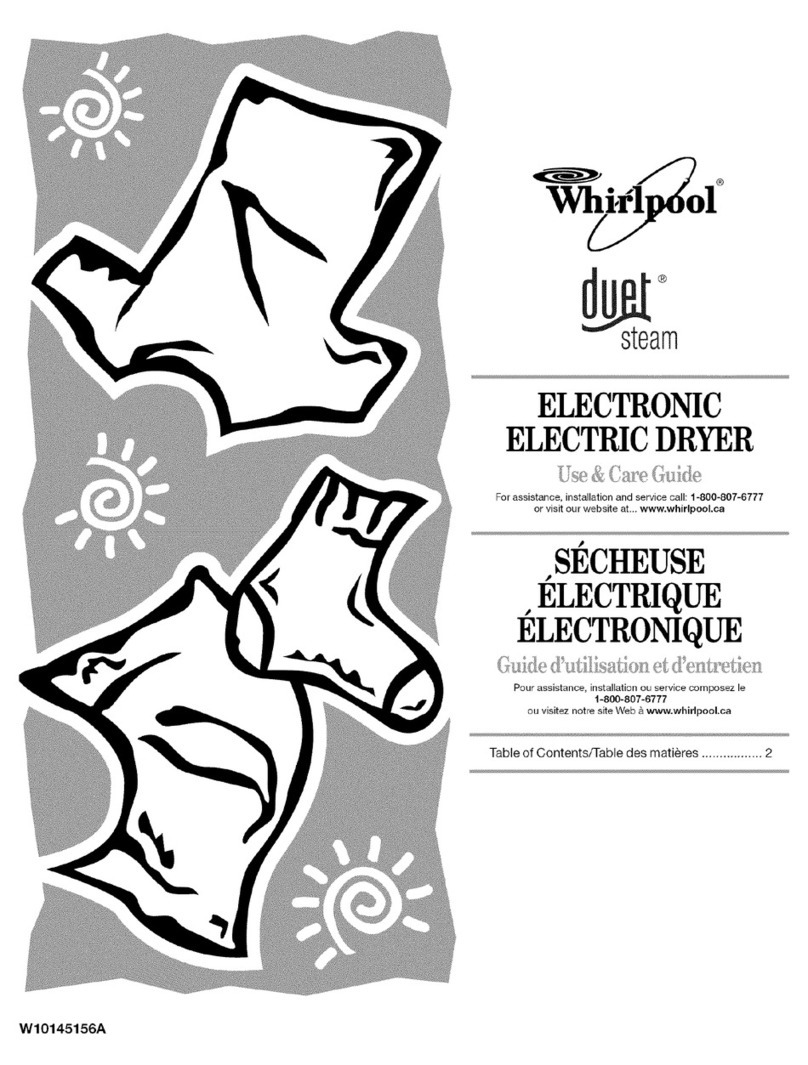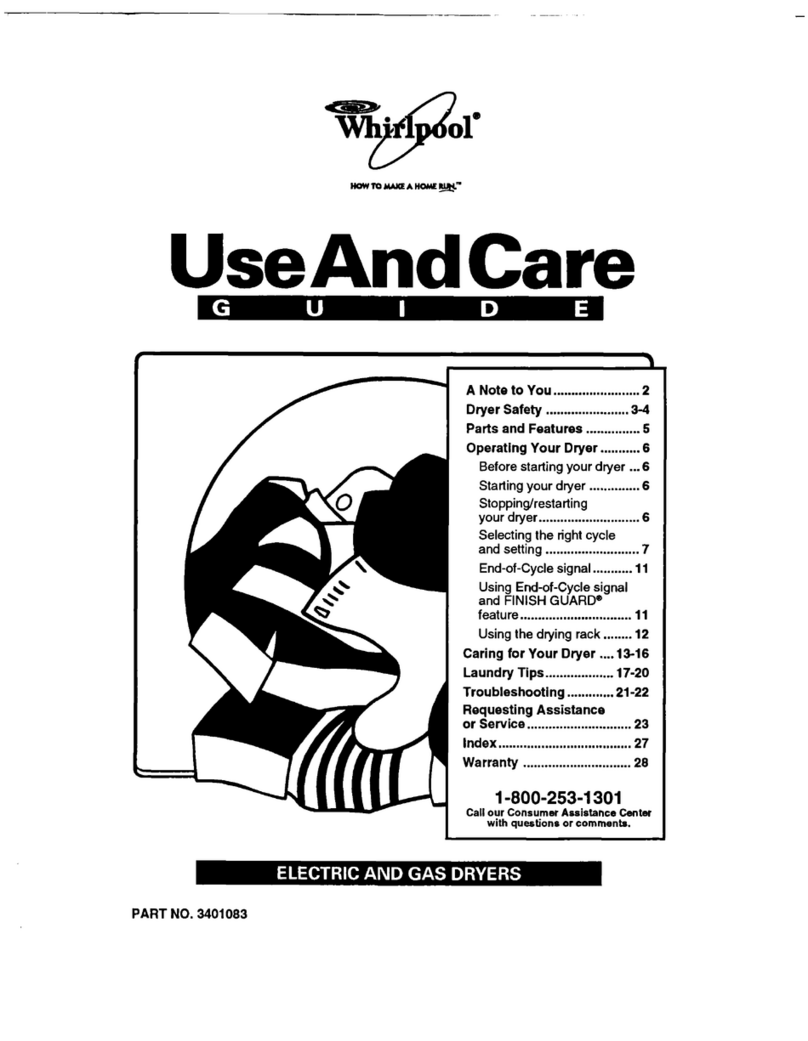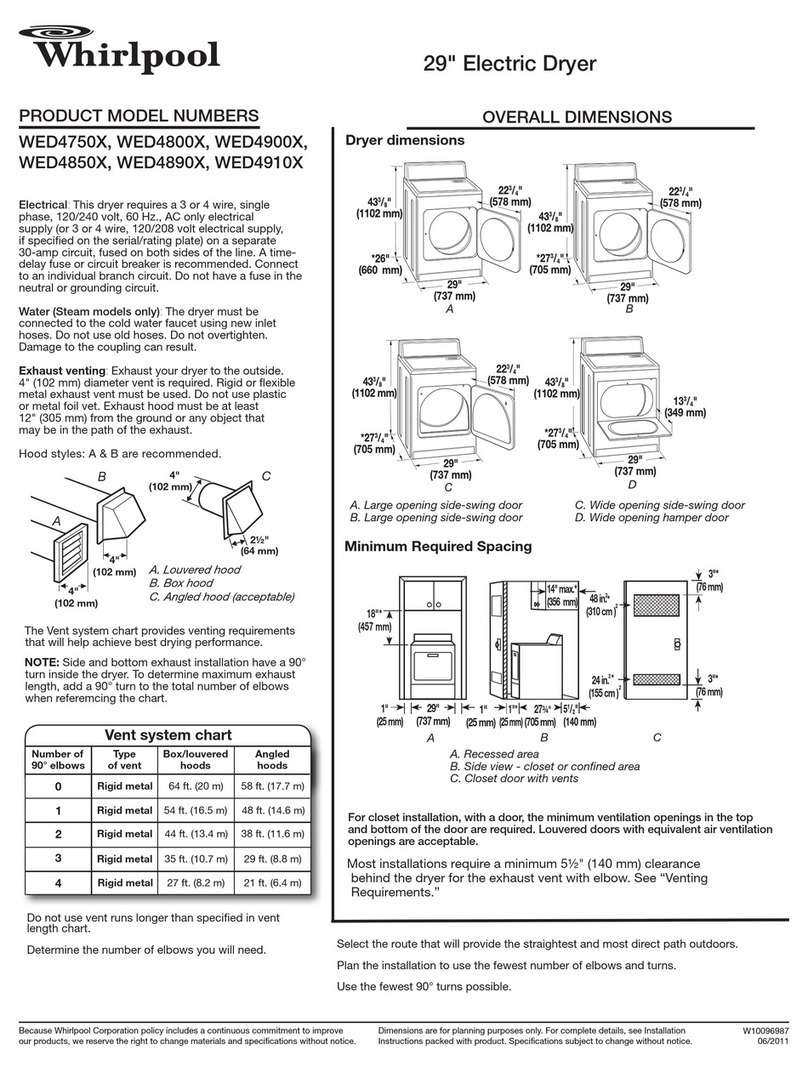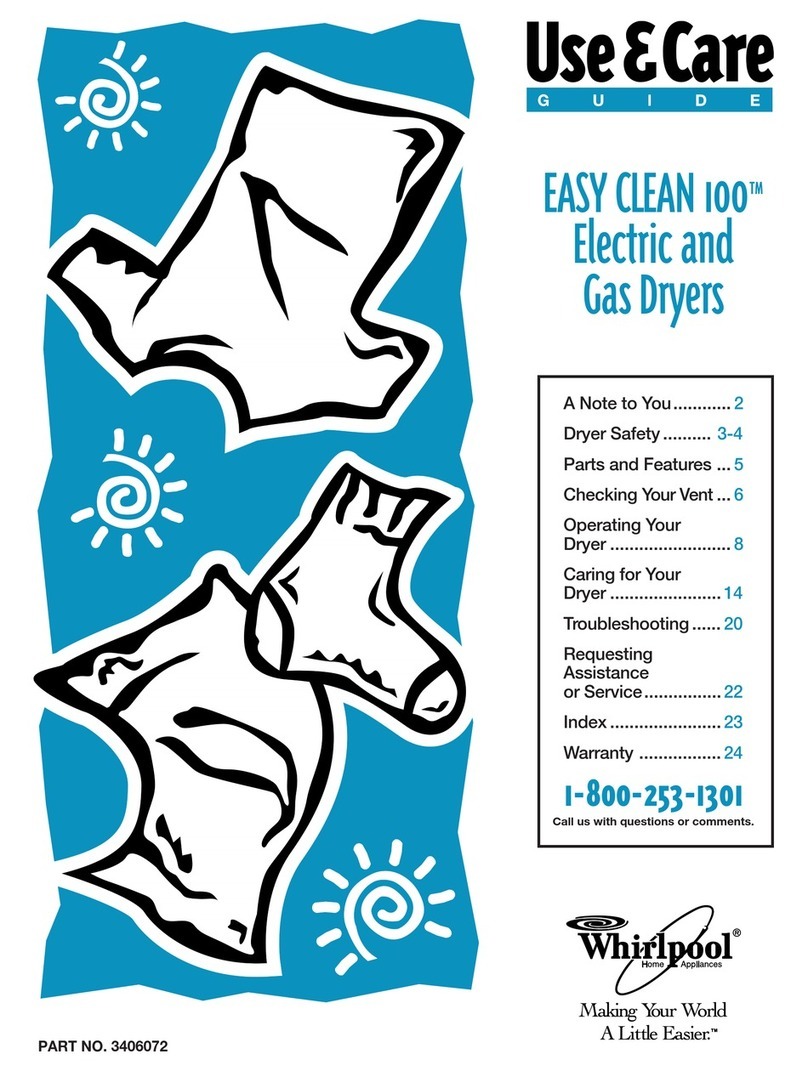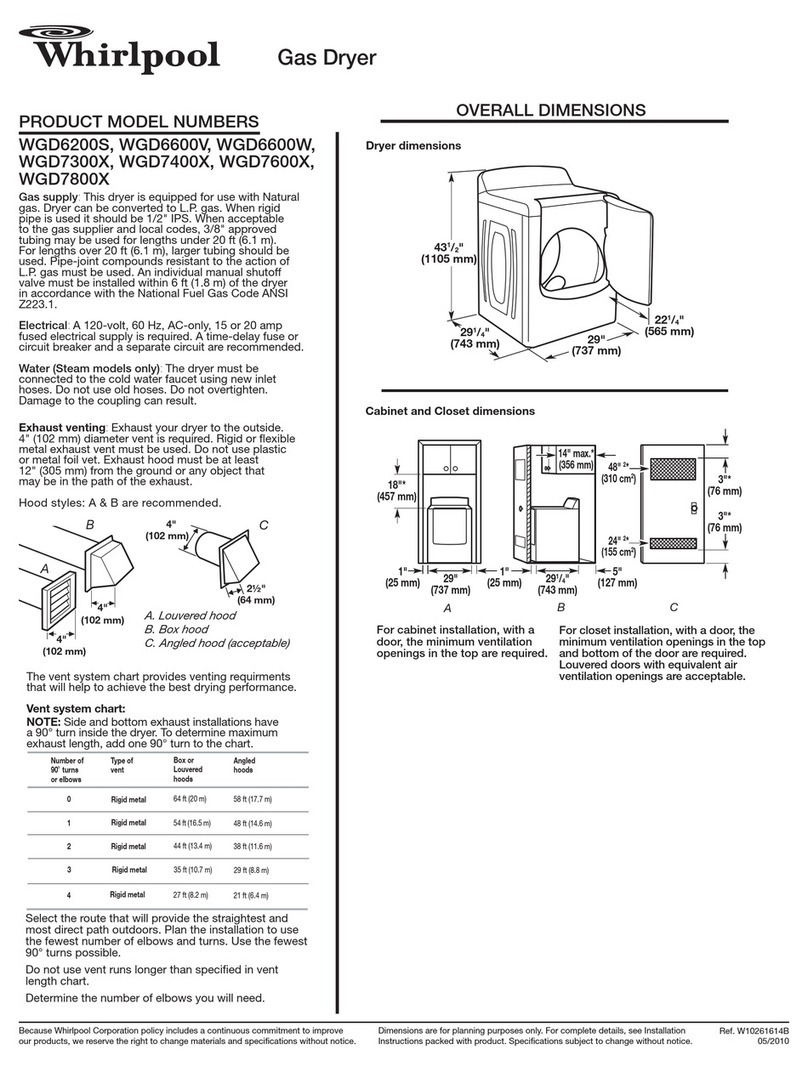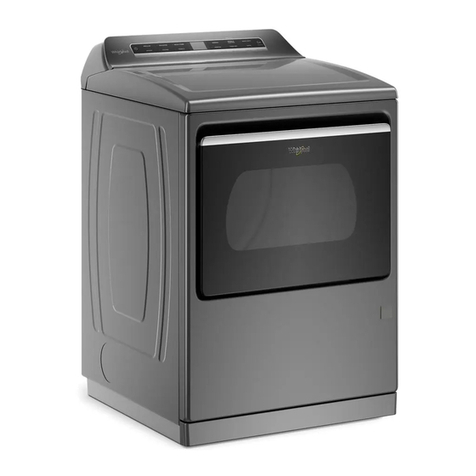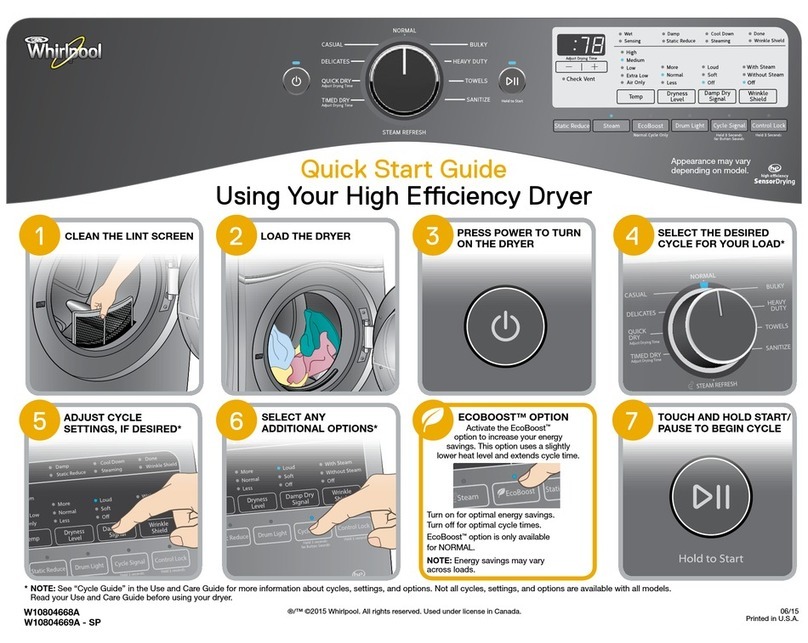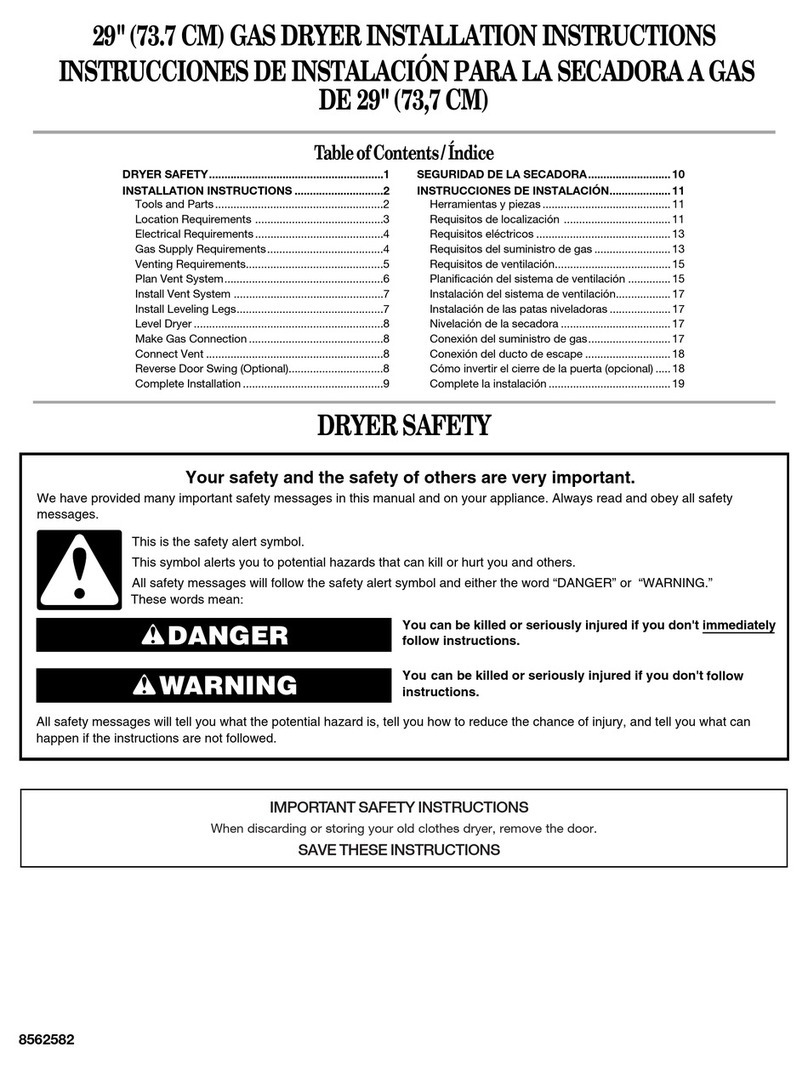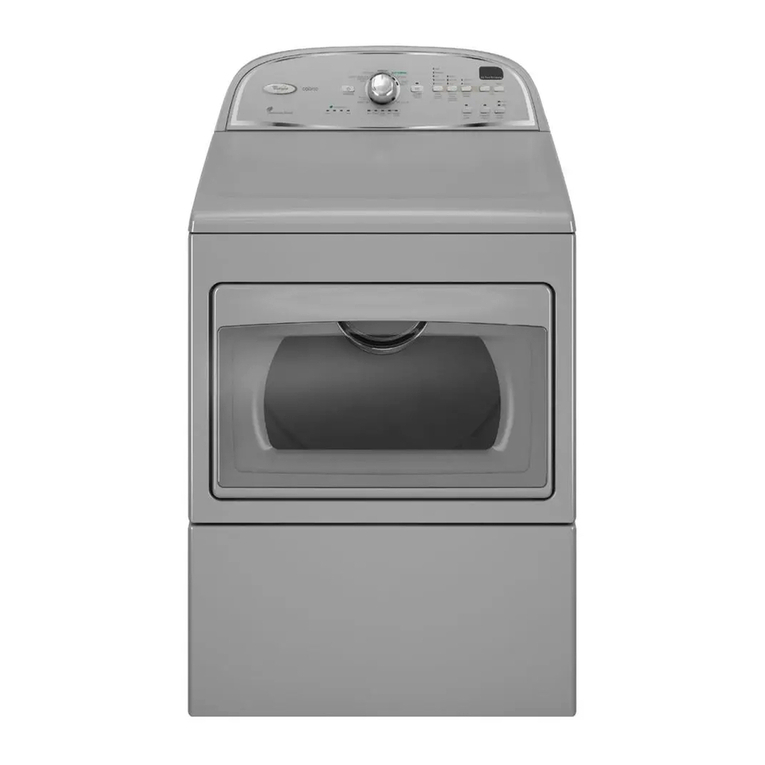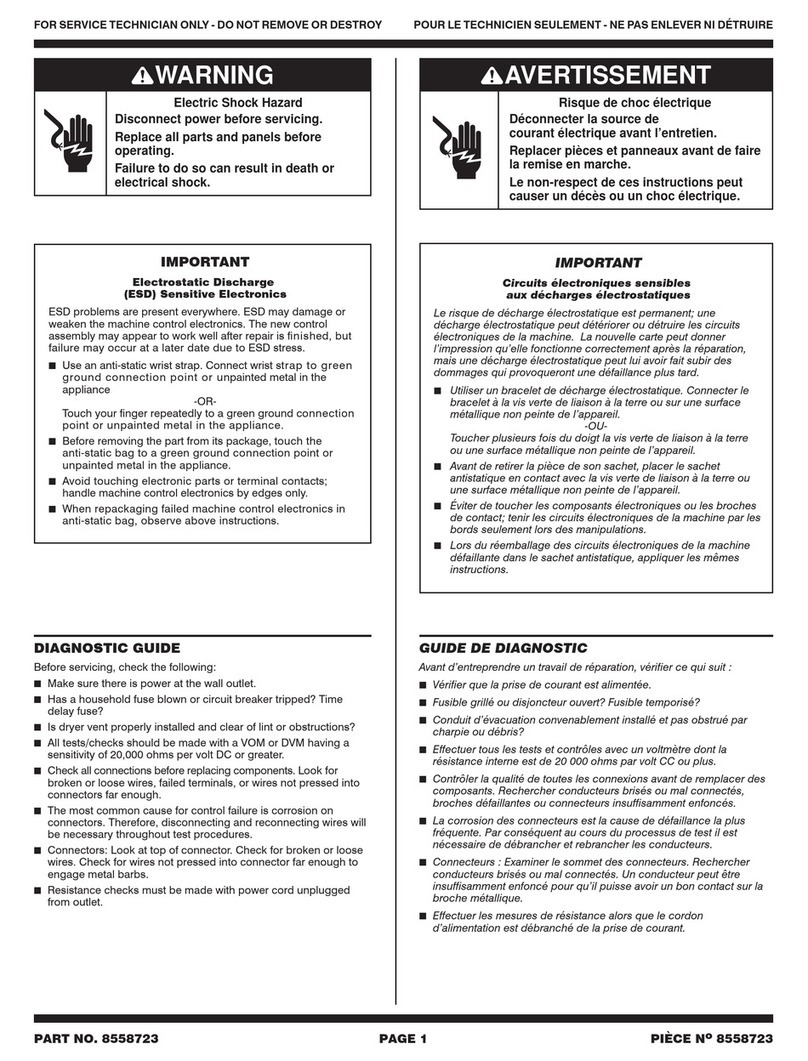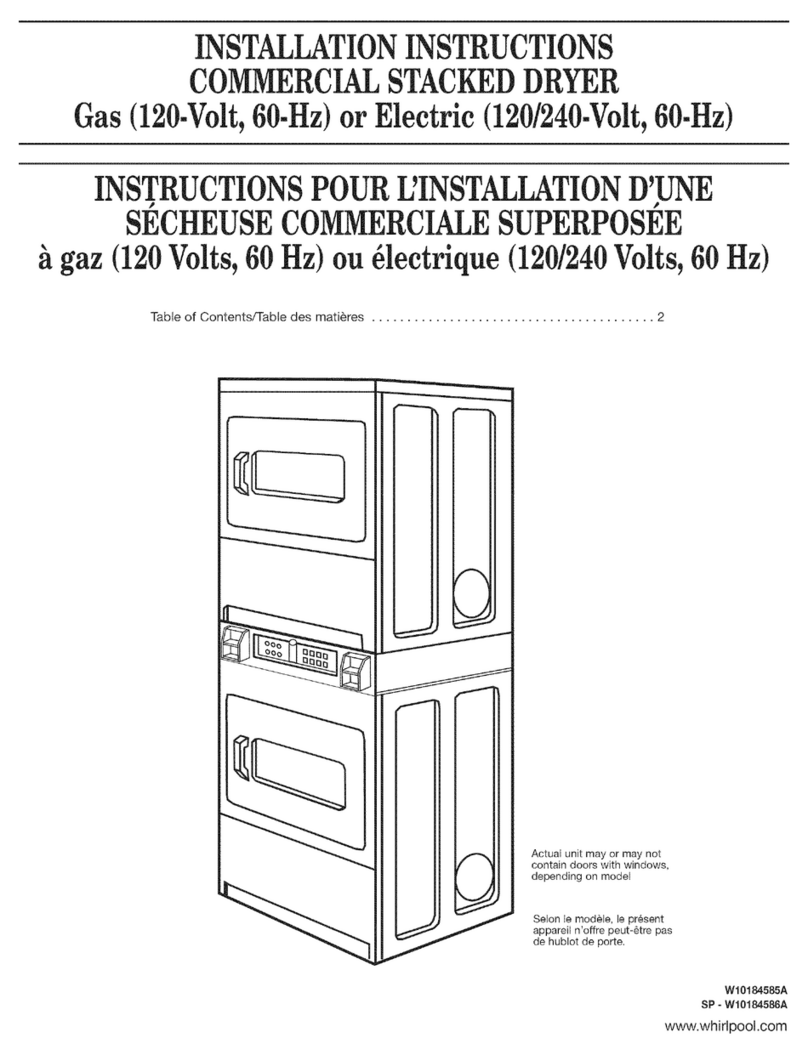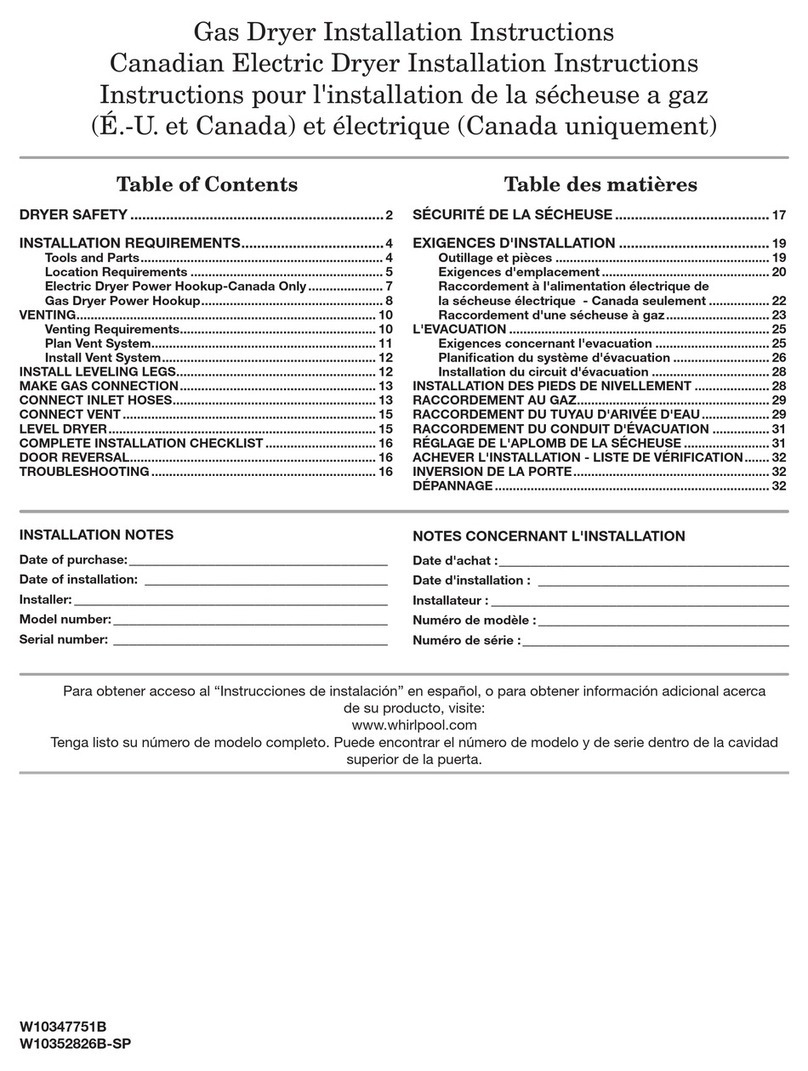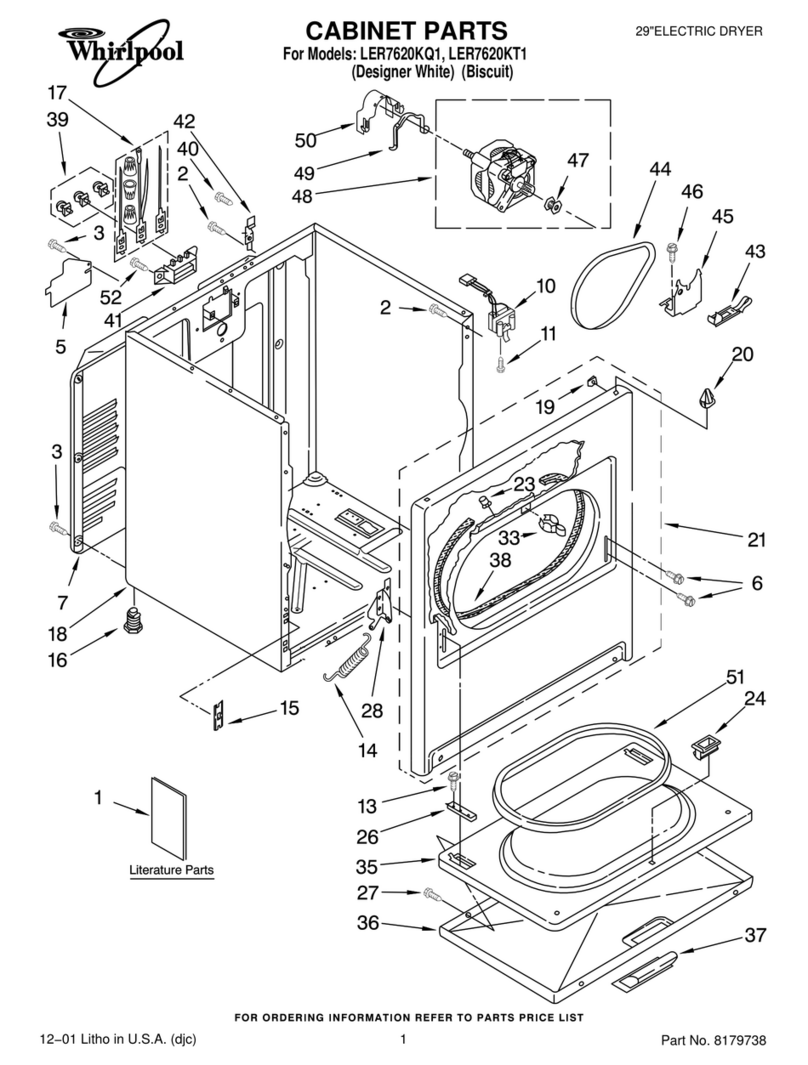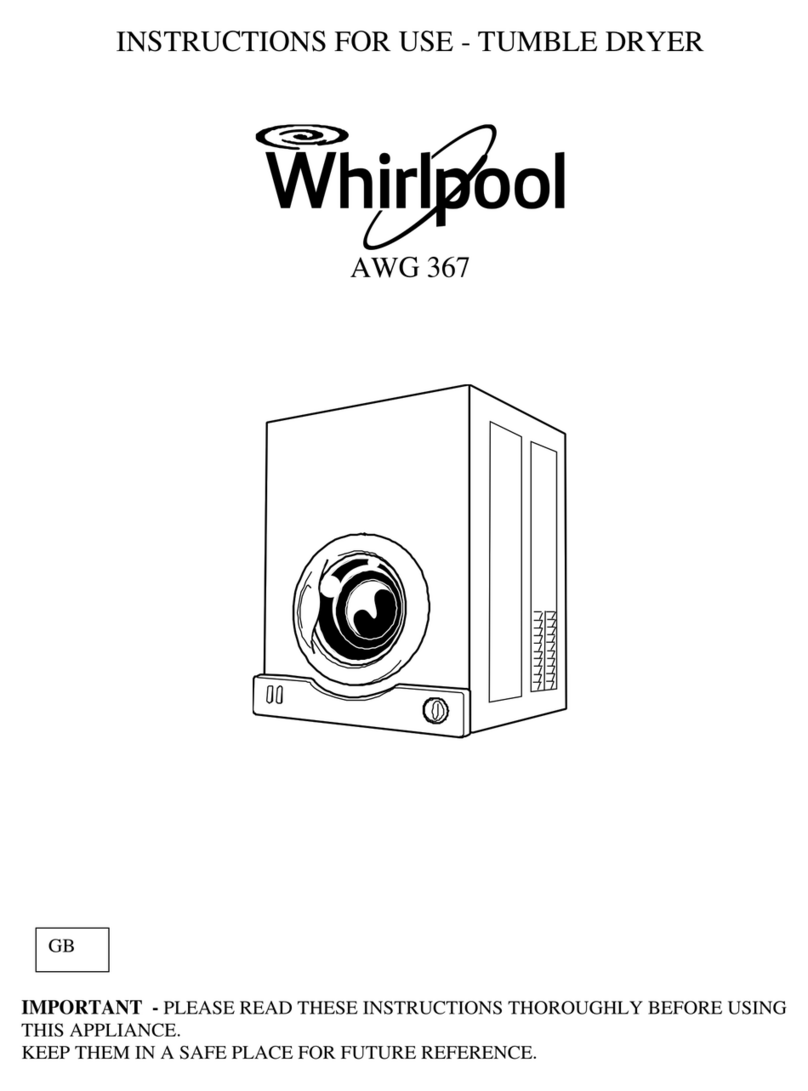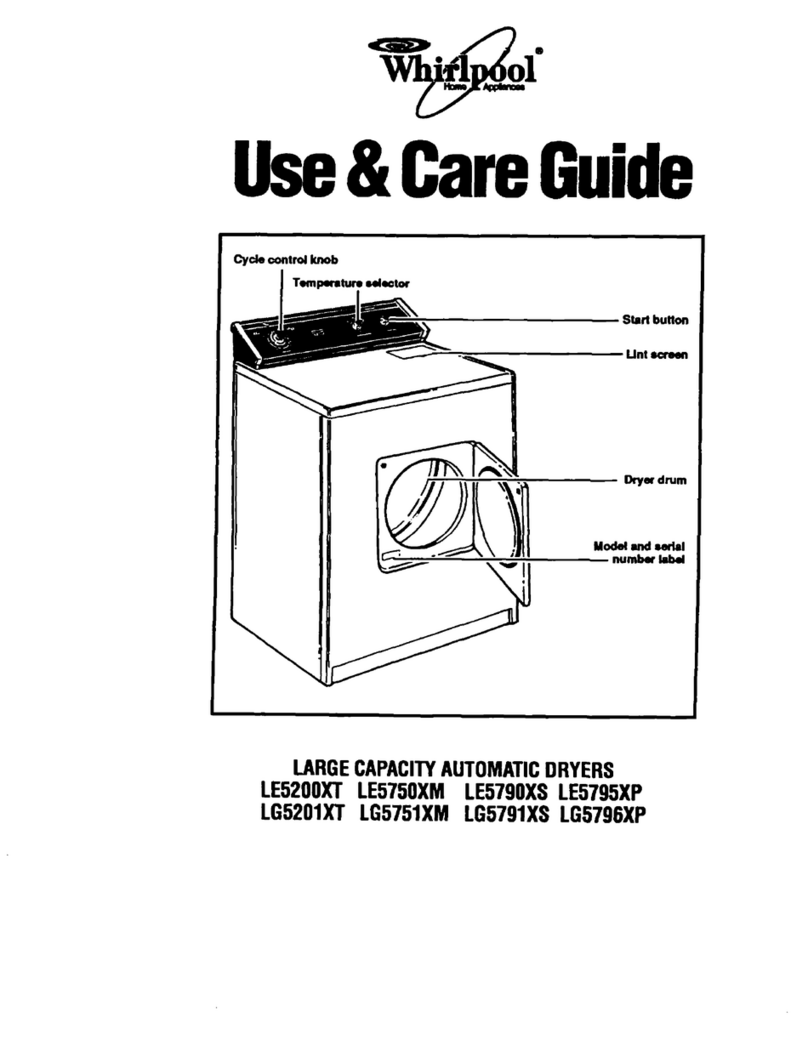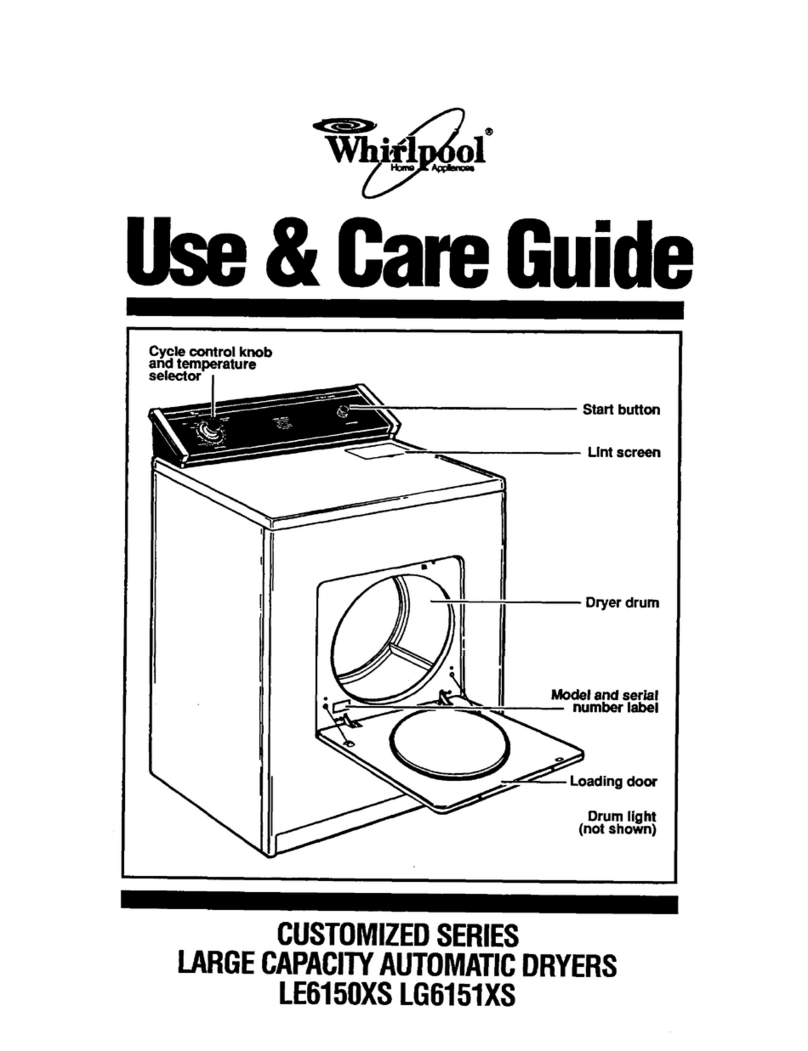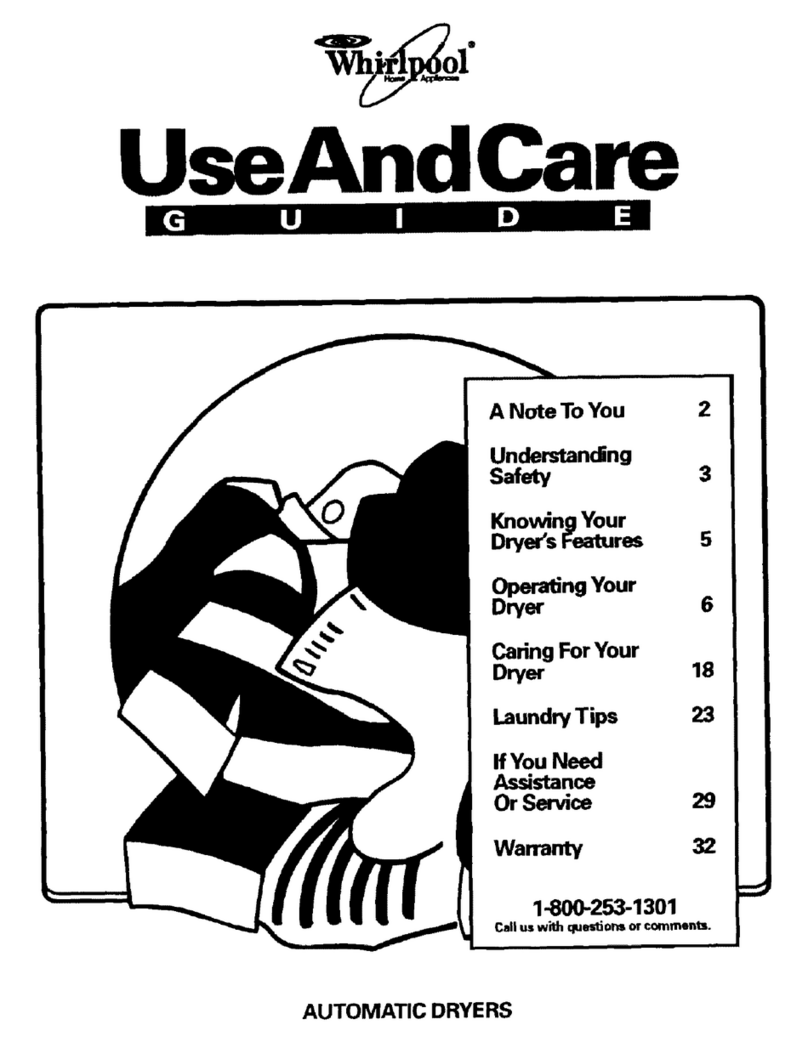I
n
Make sure that lower edges of the
cabinet, plus the back and bottom sides of the
dryer are free of obstructions to permit
adequate clearance of air openings for
combustion air. See “Recessed and closet
Installation instructions”, on the back cover, for
minimum spacing requirements.
J
w For ease of installation, operating and
servicing (if ever needed) adequate space
should be provided around the dryer.
K
n
A 1/&inch NPT plugged tapping,
accessible for test gauge connection, must be
installed immediately upstream of the gas
supply connection to the dryer.
The dryer and its individual shutoff valve must
be disconnected from the gas supply plping
system during any pressure testing of that
system,
ElectrIcal Shock Hazard
Disconnect from electrlcal supply before
removing access panel.
Do not operate dryer wlthout access panel
securely In place.
Failure to follow these lnstructlons could
result In electrlcal shock or death.
One-piece front panel
irlng diagram location
The dryer gas shutoff
valve is located
behind the one-piece
front panel.
The wiring diagram is
located inside the
console.
These Items should be
accessed only by a
quallfled service
technlclan.
e-piece front panel
1.
Disconnect electrlcal supply.
2. Remove lint screen and set aside.
3. Remove two screws from lint screen area.
4. Grasp front cabinet top corners and pull
forward and up (top is hinged at rear).
5. Remove two screws from front panel
flanges. Lift front panel off lower clips.
6. Remove door switch wires, if necessary,
and set front panel aside.
7. Reassemble in reverse order.
Note: The door switch wires must
not
touch
lower access panel
wiring diagram location
1
aDlsconnect
electrlcal supply.
2. Insert flat-blade
screwdriver between
cabinet front and
lower access panel 3
inches in from each
side. Push down on
retainer clips and
pull lower access
panel forward. The
lower access panel
is hinged at the
bottom.
3.
Close lower access
panel.
Gas shutoff valve “open” and
“closed” position
Optional shutoff
valve L-3
poritic
gas
Panel B
Electrical
requirements
Electrlcal Shock Hazard
l
ElectrIcal ground Is required on thls
appliance.
l
Do Not modlty the power supply cord plug.
HIt does not flt the outlet, have a proper
outlet Installed by a quallfled electrlclan.
l
Do Not have a fuse In the neutral or
groundlng clrcult. A fuse In the neutral or
grounding clrcult could result In an
electrlcal shock.
l
Do Not use an extension cord wlth thls
appliance.
l
Check wlth a quallfled electrlclan lf you are
In doubt as to whether the appliance Is
properly grounded.
Failure to follow these lnstructlons could result
In serious Injury or death.
Hcodes permit and a separate groundlng wire
Is used, It Is recommended that a quallfled
electrlclan determlne that the groundlng path ls
adequate.
A 120-volt, 60Hz. AC-only, 15or 2sampere
fused electrical supply Is required. Time-delay
fuse or circuit breaker is recommended. It is
recommended that a separate circuit serving
only thls appliance be provlded.
Recommended
grounding method
For your personal safety, this appliance must be
grounded. This appliance is equipped with a
power supply cord havlng a 3-prong grounding
plug. To minimize possible shock hazard, the
cord must be plugged Into a mating 3-prong
grounding-type wall receptacle, grounded in
accordance with the National Electrical Code,
ANSVNFPA 70 - latest edition, and all local
codes and ordinances. If a mating wall
receptacle is not available, it is the personal
responsibility and obligation of the customer to
have a
properly
mm Indad
3-prong rounding- -
type wal $receptacle
qualified
electrician.
power supply cord
Exhaust
requirements
Fire/Health Hazard
l
Do Not use non-metal, flexible duct.
l
Do Not use metal duct smaller than four
Inches In diameter.
l
Do Not Use exhaust hoods wlth magnetic
latches.
l
Check that exhaust system Is not longer
than specltled. Exhaust systems longer
than
speclrled will:
- Accumulate Ilnt.
- Shorten the llte ot the dryer.
- Reduce performance, resulting In
longer drying times and Increased
energy usage.
Failure to
r0ll0w
speclflcatlons may result In a
Hre.
l
Do Not exhaust dryer Into a chimney,
furnace cold alr duct, attlc or crawl space,
or any other duct used for ventlng.
* Clean the exhaust system every other year.
l
Do Not Install flexible duct In enclosed
walls, celllngs or
r
loors.
9ccumulated llnt could be fuel for a flre or
:ause molsture damage.
Ixhaust the dryer outslde to prevent
exposure to substances In the gas fuels and
:ombustlon which may be harmful to your
.lealttl .
The molsture and llnt Indoors may cause:
- Llnt to gather lnslde and around the
dryer and be a fuel for flre.
- Molsture damage to woodwork,
turnlture, palnt, wallpaper, carpet, etc.
- Housecleanlng problems and possible
health problems.
Failure to follow these lnstructlons could result
Inflre damage, property damage, personal
injury or health problems.
If uslng exlstlng exhaust system, clean llnt from
entire length of exhaust system. Make sure
exhaust hood Is not plugged with Ilnt.
Replace plastic exhaust duct wlth rlgld metal or
flexible metal duct.
Use duct tape
to seal
all joints.
n
Four-Inch rlgld metal
DIW
Is Dreferred. Plan
installation to use the
fewest number of
elbows and turns. I2 Ll-
II
Metal flexible duct
should be fully extended
and supported when the dryer is in final
position. DO NOT KINK OR CRUSH THE DUCT.
The metal tlexlble duct must be completely
open to allow adequate exhaust alr to flow.
Allow as much room as possible when using
elbows or making runs. Bend duct gradually to
avoid kinking. Remove excess flexible duct to
avold sagging and kinking that may result in
reduced air flow.
The exhaust outlet
is located at the
bottom rear of
the dryer.
The exhaust duct
can be routed up, down, left,
right or straight out of the back of the dryer.
General space requirements can be found in
“Recessed and closet installation instructions’
on the back cover. Use the straightest path you
can, where possible, to avoid 90” turns.
The maxlmum length
of the exhaust system
depends upon the type of duct used, number
of elbows and type of exhaust hood. The
maximum length for both rigid and flexible duct
is shown in chart.
YUMBER OF EXHAUST HOOD WPE
30” TURNS AI 6 IC
64Fr.
54Fr.
44Fr.
35 Fr.
27 FT.
04Fr.
54Fr.
44FT.
35 FT.
27 FT.
58F
46 F
30 F
29 F
21 F
30Fr.
31 Fr.
27 FT.
25 FT.
23 FT.
30Fr.
31 Fr.
27 FT.
25 FT.
23Fr.
20 FT.
23 FT.
19FT.
17FT.
15Fr.
MAXIMUM
LENGTH OF
4’ DIA. RIGID
METAL
DUCT.
I
MAXIMUM
LENGTH OF
4’ DIA.
FLEXIBLE
METAL
DUCT.
The maximum length using a 2” x 6” rectan 9ular duct
wlth 2 elbows and a 2-l/2 (IYPE C) exhaus hood is 8 ft.
For exhaust systems
not covered by the
exhaust length chart, see Service Manual, Part
No. 603197 available from your local parts
distributor.
Service check:
The back pressure in any
exhaust system used must not exceed 0.6
inches of water column measured with an
lncllned manometer at the point that the
exhaust duct connects the dryer.
An exhaust hood
should cap
the exhaust duct to prevent
exhausted air from returning
into dryer. The outlet of the
hood must be at least 12
inches from the ground or
anything else that may be in 12” min.
the path of the exhaust. 35
d-Inch outlet hood Is preferred.
However, a
2-l /2 inch outlet may be used wlth short
systems only. A 2-l /2 inch outlet can result in
longer drying times than other hood types.
For
permanent Installation, a stationary exhaust
system Is required.
For moblle home
Installation, the
dryer
must
have an outside exhaust.
If you exhaust the dryer
through the floor and the
area under your mobile
home is enclosed, the
exhaust system
must
terminate outside the
enclosed area. Extension
beyond the enclosure will prevent lint and
moisture buildup under the mobile home.
